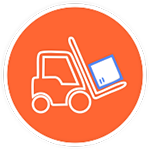What Elements Make a Successful Supply Chain?
The size of the global supply chain market continues to grow, having already reached a value of over $3 billion in 2017. But even with the growth of supply chains and third-party logistics (3PL), not all businesses are thriving with their current supply chain.
Just two months ago, Adidas announced that sales growth would be slowing due to issues with their supply chain. Adidas’ supply chain was unable to scale as quickly as the company.
Having a supply chain or a 3PL isn’t enough. Businesses must find supply chains that work with their short- and long-term goals. Of course, choosing the right supply chain is easier said than done. To find the right supply chain, take a closer look at each 3PL. The best supply chains in the world exemplify the same set of qualities — and these qualities are what make them great.
Supply chains have been around for centuries. Granted, supply chains of the past hardly resemble the streamlined supply chains of today. Thanks to advancements in software and technology, supply chains have leaped in efficiency. Your 3PL should continue to implement new tech and software to make your supply chain even better.

Supply Chain Management System
No modern supply chain runs without a supply chain management system (SCMS). This set of digital tools enables supply chain managers to analyze every link in the supply chain to find new, better ways to operate.
A SCMS should include tools such as:
- Shipping status tools
- Lean inventory tools
- Demand forecasting tools
- Analytics and reporting tools
These are just some of the tools that a SCMS offers to improve your supply chain. With the right supply chain managers operating the SCMS, supply chains become more successful than ever.

Data Collection and Use
Supply chains can harness data to make smarter decisions and prevent potential shortages from affecting the overall chain.
Before acting on data, supply chain managers must first use analytics to review it. Because nearly three-quarters of all data goes unused, the analytics step is where many supply chains can make improvements. The best supply chains should demonstrate excellent data collection, analysis, and implementation.
One reason supply chains are better than they’ve ever been lies in machine improvements, machine learning, and artificial intelligence (AI). Machines do much of the heavy lifting in supply chains — literally. Forklifts, trucks, planes, and every piece of machinery used from the warehouse to the point of delivery all play a role in creating a successful supply chain.

Automation
Automation is a simple way to reduce costs while increasing productivity. One prediction has AI becoming a component of one-quarter of all supply chain solutions by 2023. That means even more automation.
But choosing to automate isn’t always the right option. 3PLs should be implementing the right technologies to cut operating costs and increase productivity without breaking the bank on overhead.
As more machines become automated, picking the best machines will have a profound impact on the quality of the supply chain.

IoT Sensors
The Internet of Things (IoT) is reaching into more and more industries. Whether you’ve noticed or not, IoT has already changed the way supply chains operate.
IoT sensors, which can measure just about anything, are used to gather data to streamline supply chain processes. One commonly used IoT device, RFID chips, continuously track goods that move through warehouses, reducing the chance of losing items.
Existing supply chains won’t stay the same forever. Changes in supply and demand continually put pressure on supply chain managers to scale and adjust. Successful supply chains separate themselves with their processes, plans, and efficient reactions to hurdles.

Inventory Management
The longer goods or supplies sit in a warehouse, the more they threaten to slow down your supply chain and run up costs. The key to efficient warehousing is better inventory management.
Inventory management includes everything from holding the right amount of a good to keeping track of every item. Many modern supply chain managers use RFID tags and SCMSs to find the perfect balance.
Beyond simple inventory management, many supply chains run a lean inventory style of management. Lean inventory, which has warehouses hold the bare minimum necessary for projected demand, is only achievable when every part of the supply chain is running smoothly.

Scalability
Maybe more than anything else, a successful supply chain should be scalable. Whenever a supply or demand shock hits a market, supply chains should be able to either:
- Scale back to decrease inventory and overhead.
- Scale up to maximize profit.
Scalability also affects resource procurement, distribution, and inventory management. When working with a 3PL to create a supply chain plan, your 3PL should analyze market trends to ensure your supply chain will scale when necessary.

Flexibility
In conjunction with scalability, supply chains must react quickly to changes in supply, demand, and the business ecosystem. This is called supply chain flexibility, and every supply chain should embrace it.
Consider a sudden shock to a supply chain where demand is expected to increase by 30%. Your supply chain’s scalability lets you purchase the goods and supplies necessary to meet the demand. But how quickly will the supplies reach a factory, and how much longer will moving the goods take your fleet? The best supply chains have room to bend, enabling your business to take advantage of these opportunities.
Rarely do businesses run and operate their own warehouses and fleets effectively. Doing so is expensive and time-consuming.
However, any business that chooses a 3PL must also use their employees. While demand planners, supply chain managers, and logisticians get all the glory, the best supply chains start with their warehouse workers and fleets.
Warehousing is an evolving industry, relying more and more on AI and machinery. But warehouse workers will always be needed, especially when scaling up during busy seasons. Leave staffing to 3PLs that understand which workers will be best.
Fleets, like warehouses, can either be a point of pride or pain, especially if the costs of operating a fleet are becoming increasingly expensive. Choosing between a private or outsourced fleet is a big decision, and costs to consider include:
- Fleet maintenance
- Gas prices
- Acquiring new vehicles
- Employing drivers
Effective supply chains have affordable, efficient warehouses and fleets. A supply chain that doesn’t have qualified employees has room to improve.
Supply chains are paying more attention to the costs of operation beyond the bottom line. This means making a commitment to sustainability.
No, sustainability doesn’t reduce overhead in the short run, and making eco-conscious decisions can increase some costs of business. But sustainable fleets are more energy-efficient, and going green can lead to financial benefits.Attention to sustainability is a sign that a supply chain is forward-focused. Shifting to electric forklifts might be an expensive one-time cost, but the benefits of doing so justify the expense.









